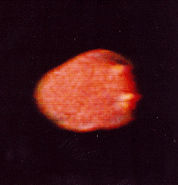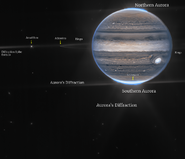Amalthea, also known as Jupiter V, is an inner prograde satellite belonging to the planet of Jupiter. It was discovered on September 9, 1892 by Edward Emerson Barnard.
Amalthea is the reddest object in the Solar System. This is possibly due to Amalthea collecting sulfur compounds that rain down from Io.
Amalthea makes up its own group known as the Amalthea group, which is made up of Metis, Adrastea, Thebe and itself.
Composition[]
Similar to Thebe, Amalthea is thought to consist of porous water ice, likely with rocks and metals interspersed. Its surface is coated in a reddish dust, with less red patches where the underlying ice is exposed.
Formation[]
It is currently unknown how Amalthea formed. It may have formed further than the planet than its current orbit or may have been a stray asteroid from the asteroid belt captured by Jupiter.
Surface[]
The surface of Amalthea is reddish-orange possibly due to sulfur from Io's volcanism. With a surface darker than those of the other inner satellites of Jupiter. Amalthea has lighter patches on the surface, yet the nature or origin is currently unknown by astronomers. The surface is full of craters from previous impacts and collisions with other minor moons.
| Geology of Amalthea | |
|---|---|
| Craters | Gaea • Pan |
| Faculae | Ida • Lyctos |
Orbit and Rotation[]
Amalthea takes twelve hours a day (Or half of an Earth day) to make one orbit around Jupiter. Amalthea is tidally locked, which means it always keeps on side facing towards Jupiter.









